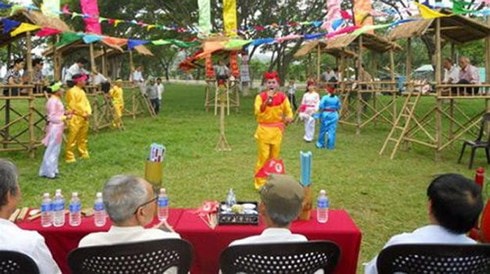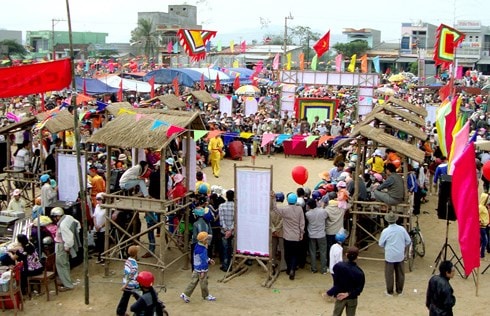The recognition of Bai Choi as an intangible cultural heritage
(QNO) - The art of Bai Choi in Central Vietnam was officially recognized as an Intangible Cultural Heritage of humanity by UNESCO on December 7, 2017.
 |
| Bai Choi singing |
The art of Bai Choi in Central Viet Nam (including the provinces of Quang Binh, Quang Tri, Thua Thien-Hue, Quang Nam, Quang Ngai, Binh Dinh, Khanh Hoa, Phu Yen, and Da Nang city) is a diverse art combining music, poetry, acting, painting and literature. There are two main forms: Bai Choi games and Bai Choi performances.
Bai Choi games involve a card game played in bamboo huts during the Tet holiday (Lunar New Year). In Bai Choi performances, male and female artists called Hieu perform on a sedge mat, either moving to and fro between places or on private occasions of families. The bearers and practitioners of Bai Choi are Mr. and Ms. Hieu, solo Bai Choi performers, card-making artisans.
The art of Bai Choi is a form of culture and recreation within communities. Performers and their families play an important role in safeguarding the practice by teaching Bai Choi repertoires and singing skills, performance techniques and card-making methods to younger generations. Together with communities, these performers have set up nearly 90 teams, groups and clubs to practise and transmit the art of Bai Choi, which attracts wide community participation. Most of the performers of Bai Choi learn their skills orally within the family. However, the art of Bai Choi is now transmitted in associations, clubs, and schools.
 |
| The art of Bai Choi shows the rich cultural identity of the Vietnamese people. |
According to the Intergovernmental Committee for the Safeguarding of Intangible Cultural Heritage, the nomination file for the art of Bai Choi in Central Vietnam met 5 criteria for registration on the Representative List of the Intangible Cultural Heritage of Humanity as follows.
1. The art of Bai Choi is an important cultural activity in the village community, meeting the communities’ needs of entertainment and art enjoyment. The lyrics of Bai Choi are moral lessons, expressing the love of the homeland, community solidarity and living experiences. The important roles of the heritage keeper and transmission have been mentioned. The practice of Bai Choi has promoted gender equality and mutual respect among communities.
2. The recognition of the art of Bai Choi as an intangible cultural heritage of humanity encourages dialogue between communities, groups and individuals. It provides an opportunity to exchange experiences among practitioners, enriching the knowledge and skills related to the practice of art forms. The inscription may strengthen the links between individuals, groups and clubs practicing this cultural heritage and other cultural traditions through performances and festivals. Moreover, the inscription helps to raise awareness of the diverse significances of the intangible cultural heritage as Bai Choi is a combination of several cultural and artistic fields.
3. The nomination file represented in detail the past and present efforts to safeguard the heritage and ensure the existence of communities, groups and clubs with the support of Government. These efforts included the promulgation of the art of Bai Choi, the organization of workshops on Bai Choi and related cultural activities, Bai Choi festivals, performances, and the teaching of singing, performance, making cards, and play the game.
4. The art of Bai Choi was nominated following the wide participation of the communities, groups and individuals concerned and with their free, prior and informed consent. It was illustrated by the records, videos and interviews in which the art of Bai Choi was practised.
5. The art of Bai Choi is included in the inventory of the national intangible cultural heritages in the period of 2014-2016 by the Ministry of Culture, Sports and Tourism of Vietnam. The information of Bai Choi inventory is annually reported by the localities of Bai Choi. It is managed, restored and annually updated at the Vietnam Music Institute.
